2016 MERCEDES-BENZ GLS SUV belt
[x] Cancel search: beltPage 62 of 397
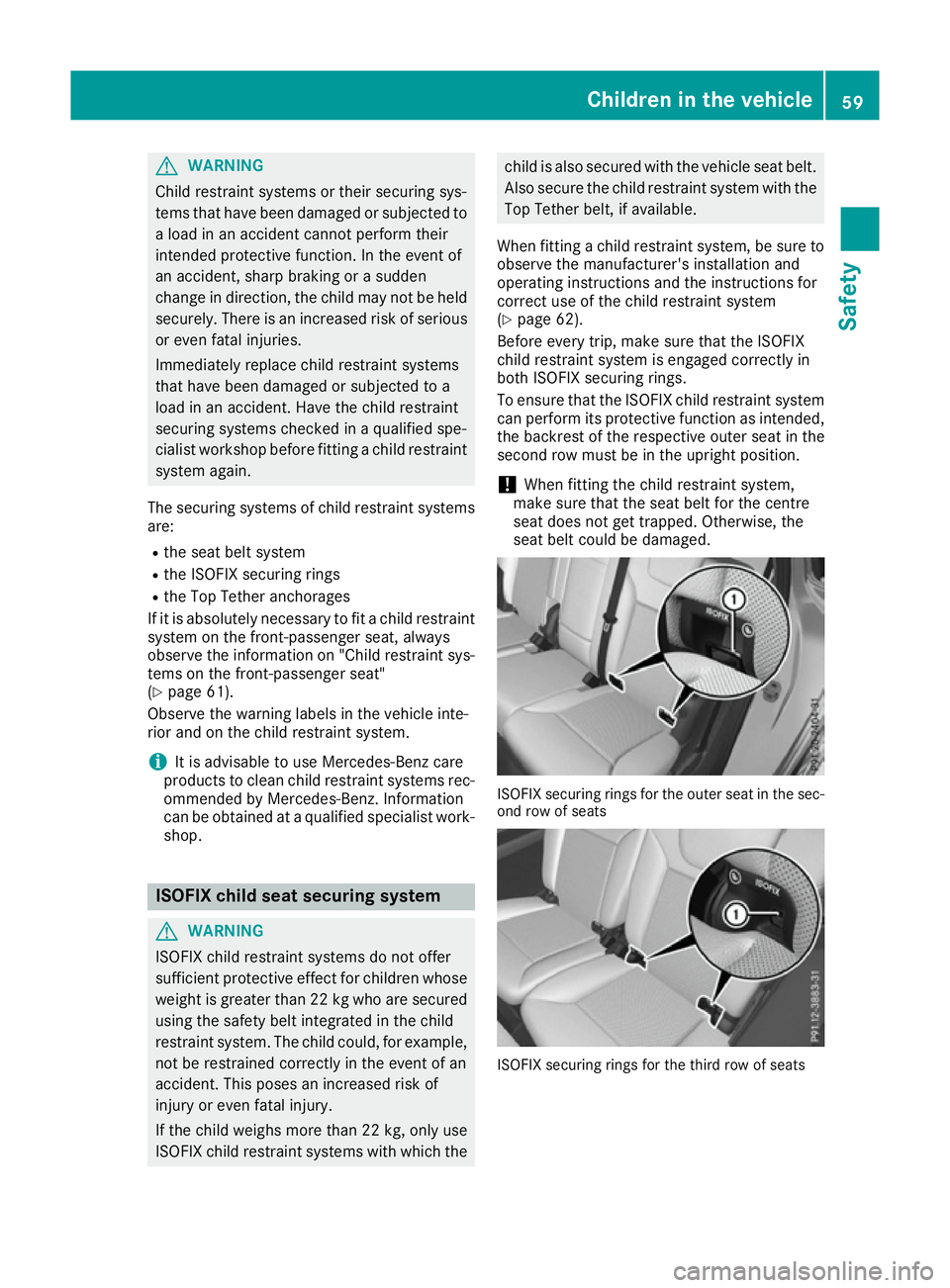
G
WARNING
Child restraint systems or their securing sys-
tems that have been damaged or subjected to a load in an accident cannot perform their
intended protective function. In the event of
an accident, sharp braking or a sudden
change in direction, the child may not be held securely. There is an increased risk of serious
or even fatal injuries.
Immediately replace child restraint systems
that have been damaged or subjected to a
load in an accident. Have the child restraint
securing systems checked in a qualified spe-
cialist workshop before fitting a child restraint
system again.
The securing systems of child restraint systems
are:
R the seat belt system
R the ISOFIX securing rings
R the Top Tether anchorages
If it is absolutely necessary to fit a child restraint
system on the front-passenger seat, always
observe the information on "Child restraint sys- tems on the front-passenger seat"
(Y page 61).
Observe the warning labels in the vehicle inte-
rior and on the child restraint system.
i It is advisable to use Mercedes-Benz care
products to clean child restraint systems rec- ommended by Mercedes-Benz. Information
can be obtained at a qualified specialist work-
shop. ISOFIX child seat securing system
G
WARNING
ISOFIX child restraint systems do not offer
sufficient protective effect for children whose weight is greater than 22 kg who are securedusing the safety belt integrated in the child
restraint system. The child could, for example, not be restrained correctly in the event of an
accident. This poses an increased risk of
injury or even fatal injury.
If the child weighs more than 22 kg, only use
ISOFIX child restraint systems with which the child is also secured with the vehicle seat belt.
Also secure the child restraint system with the Top Tether belt, if available.
When fitting a child restraint system, be sure to observe the manufacturer's installation and
operating instructions and the instructions for
correct use of the child restraint system
(Y page 62).
Before every trip, make sure that the ISOFIX
child restraint system is engaged correctly in
both ISOFIX securing rings.
To ensure that the ISOFIX child restraint system can perform its protective function as intended,
the backrest of the respective outer seat in the
second row must be in the upright position.
! When fitting the child restraint system,
make sure that the seat belt for the centre
seat does not get trapped. Otherwise, the
seat belt could be damaged. ISOFIX securing rings for the outer seat in the sec-
ond row of seats ISOFIX securing rings for the third row of seats Children in the vehicle
59Safety Z
Page 63 of 397
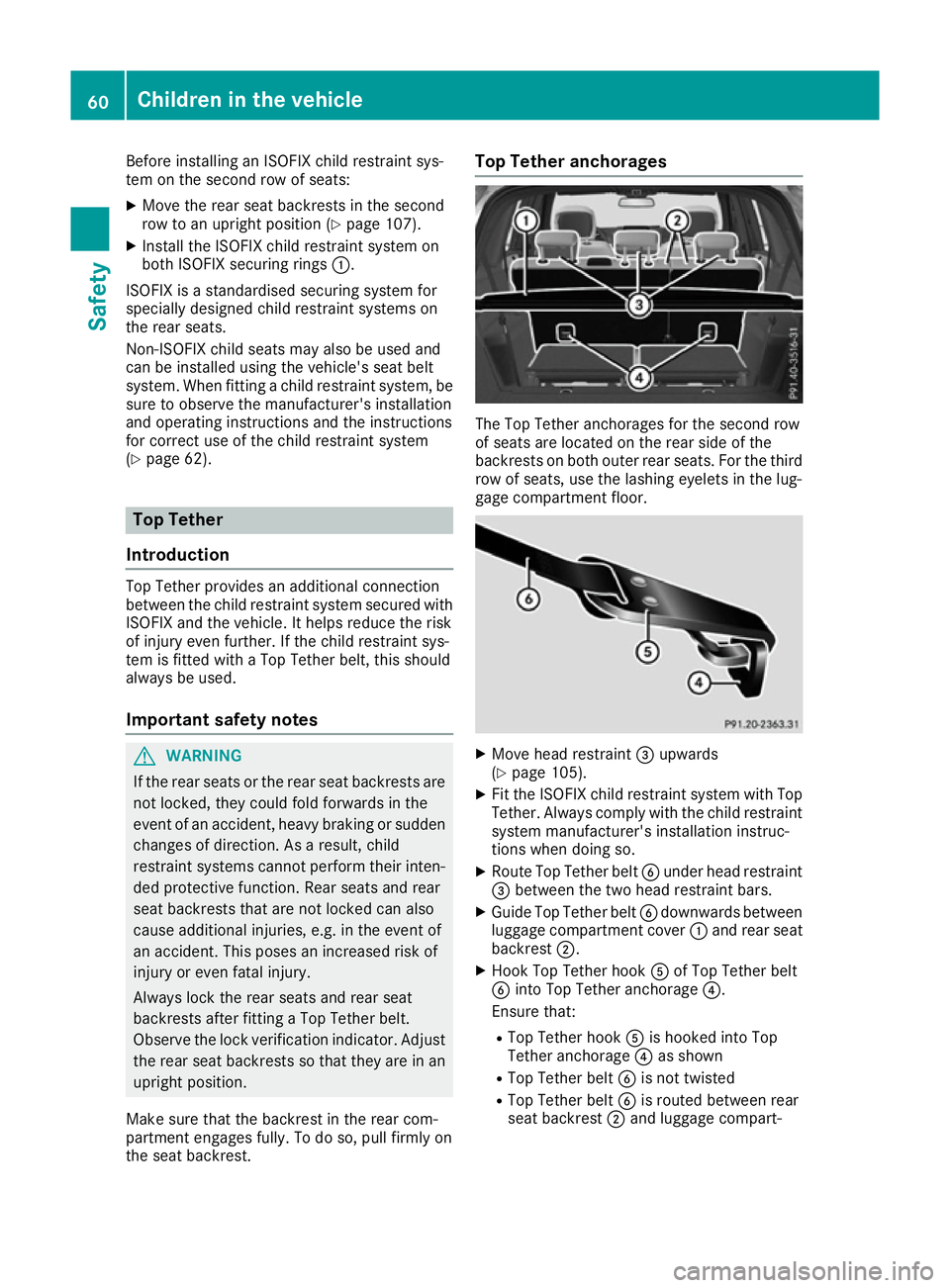
Before installing an ISOFIX child restraint sys-
tem on the second row of seats:
X Move the rear seat backrests in the second
row to an upright position (Y page 107).
X Install the ISOFIX child restraint system on
both ISOFIX securing rings :.
ISOFIX is a standardised securing system for
specially designed child restraint systems on
the rear seats.
Non-ISOFIX child seats may also be used and
can be installed using the vehicle's seat belt
system. When fitting a child restraint system, be sure to observe the manufacturer's installation
and operating instructions and the instructions
for correct use of the child restraint system
(Y page 62). Top Tether
Introduction Top Tether provides an additional connection
between the child restraint system secured with
ISOFIX and the vehicle. It helps reduce the risk
of injury even further. If the child restraint sys-
tem is fitted with a Top Tether belt, this should
always be used.
Important safety notes G
WARNING
If the rear seats or the rear seat backrests are not locked, they could fold forwards in the
event of an accident, heavy braking or sudden changes of direction. As a result, child
restraint systems cannot perform their inten-
ded protective function. Rear seats and rear
seat backrests that are not locked can also
cause additional injuries, e.g. in the event of
an accident. This poses an increased risk of
injury or even fatal injury.
Always lock the rear seats and rear seat
backrests after fitting a Top Tether belt.
Observe the lock verification indicator. Adjust the rear seat backrests so that they are in an
upright position.
Make sure that the backrest in the rear com-
partment engages fully. To do so, pull firmly on
the seat backrest. Top Tether anchorages
The Top Tether anchorages for the second row
of seats are located on the rear side of the
backrests on both outer rear seats. For the third
row of seats, use the lashing eyelets in the lug-
gage compartment floor. X
Move head restraint =upwards
(Y page 105).
X Fit the ISOFIX child restraint system with Top
Tether. Always comply with the child restraint
system manufacturer's installation instruc-
tions when doing so.
X Route Top Tether belt Bunder head restraint
= between the two head restraint bars.
X Guide Top Tether belt Bdownwards between
luggage compartment cover :and rear seat
backrest ;.
X Hook Top Tether hook Aof Top Tether belt
B into Top Tether anchorage ?.
Ensure that:
R Top Tether hook Ais hooked into Top
Tether anchorage ?as shown
R Top Tether belt Bis not twisted
R Top Tether belt Bis routed between rear
seat backrest ;and luggage compart- 60
Children in the vehicleSafety
Page 64 of 397
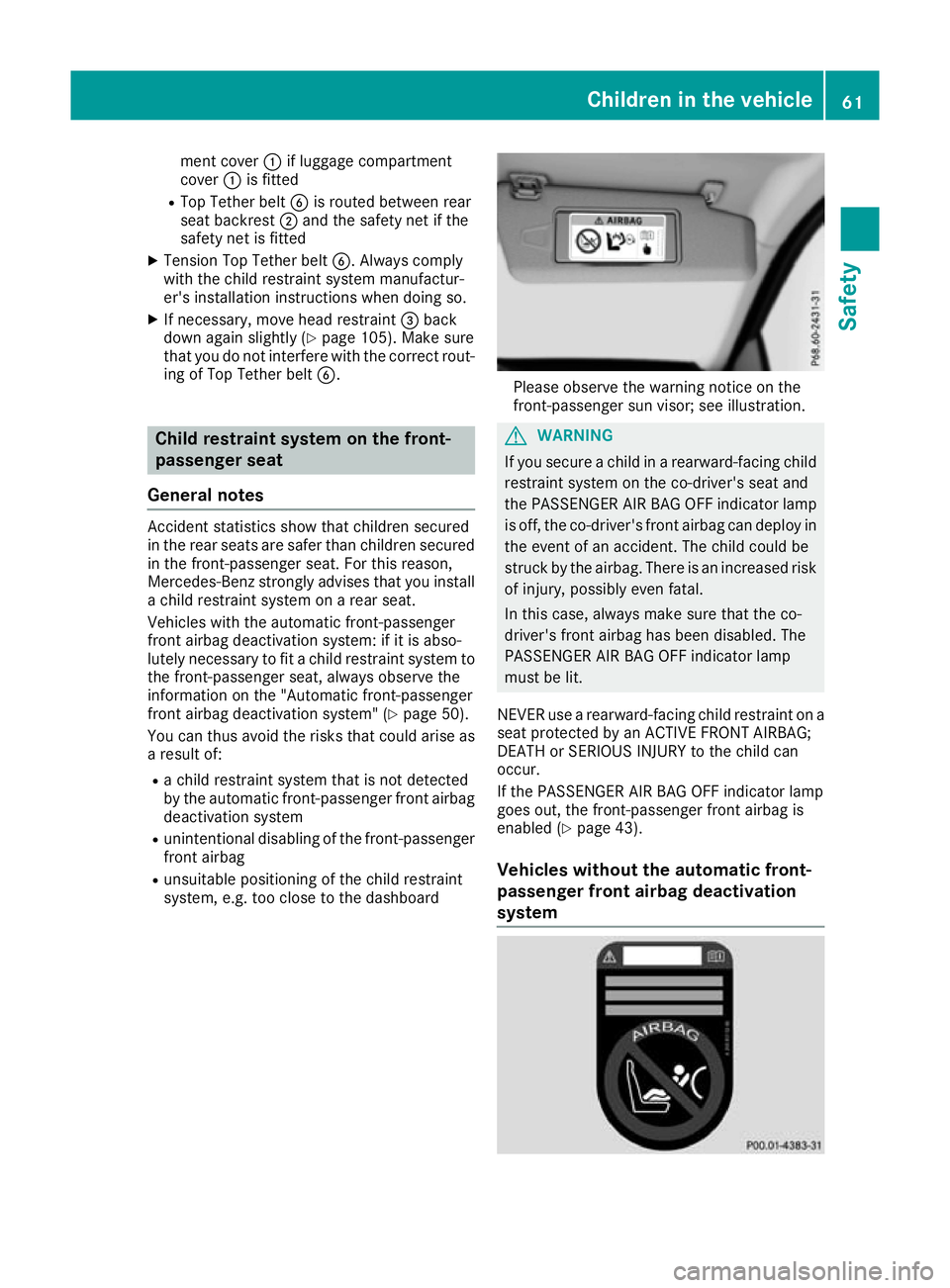
ment cover
:if luggage compartment
cover :is fitted
R Top Tether belt Bis routed between rear
seat backrest ;and the safety net if the
safety net is fitted
X Tension Top Tether belt B. Always comply
with the child restraint system manufactur-
er's installation instructions when doing so.
X If necessary, move head restraint =back
down again slightly (Y page 105). Make sure
that you do not interfere with the correct rout-
ing of Top Tether belt B. Child restraint system on the front-
passenger seat
General notes Accident statistics show that children secured
in the rear seats are safer than children secured
in the front-passenger seat. For this reason,
Mercedes-Benz strongly advises that you install a child restraint system on a rear seat.
Vehicles with the automatic front-passenger
front airbag deactivation system: if it is abso-
lutely necessary to fit a child restraint system to the front-passenger seat, always observe the
information on the "Automatic front-passenger
front airbag deactivation system" (Y page 50).
You can thus avoid the risks that could arise as
a result of:
R a child restraint system that is not detected
by the automatic front-passenger front airbag
deactivation system
R unintentional disabling of the front-passenger
front airbag
R unsuitable positioning of the child restraint
system, e.g. too close to the dashboard Please observe the warning notice on the
front-passenger sun visor; see illustration. G
WARNING
If you secure a child in a rearward-facing child
restraint system on the co-driver's seat and
the PASSENGER AIR BAG OFF indicator lamp
is off, the co-driver's front airbag can deploy in the event of an accident. The child could be
struck by the airbag. There is an increased risk
of injury, possibly even fatal.
In this case, always make sure that the co-
driver's front airbag has been disabled. The
PASSENGER AIR BAG OFF indicator lamp
must be lit.
NEVER use a rearward-facing child restraint on a
seat protected by an ACTIVE FRONT AIRBAG;
DEATH or SERIOUS INJURY to the child can
occur.
If the PASSENGER AIR BAG OFF indicator lamp
goes out, the front-passenger front airbag is
enabled (Y page 43).
Vehicles without the automatic front-
passenger front airbag deactivation
system Children in the vehicle
61Safety Z
Page 65 of 397
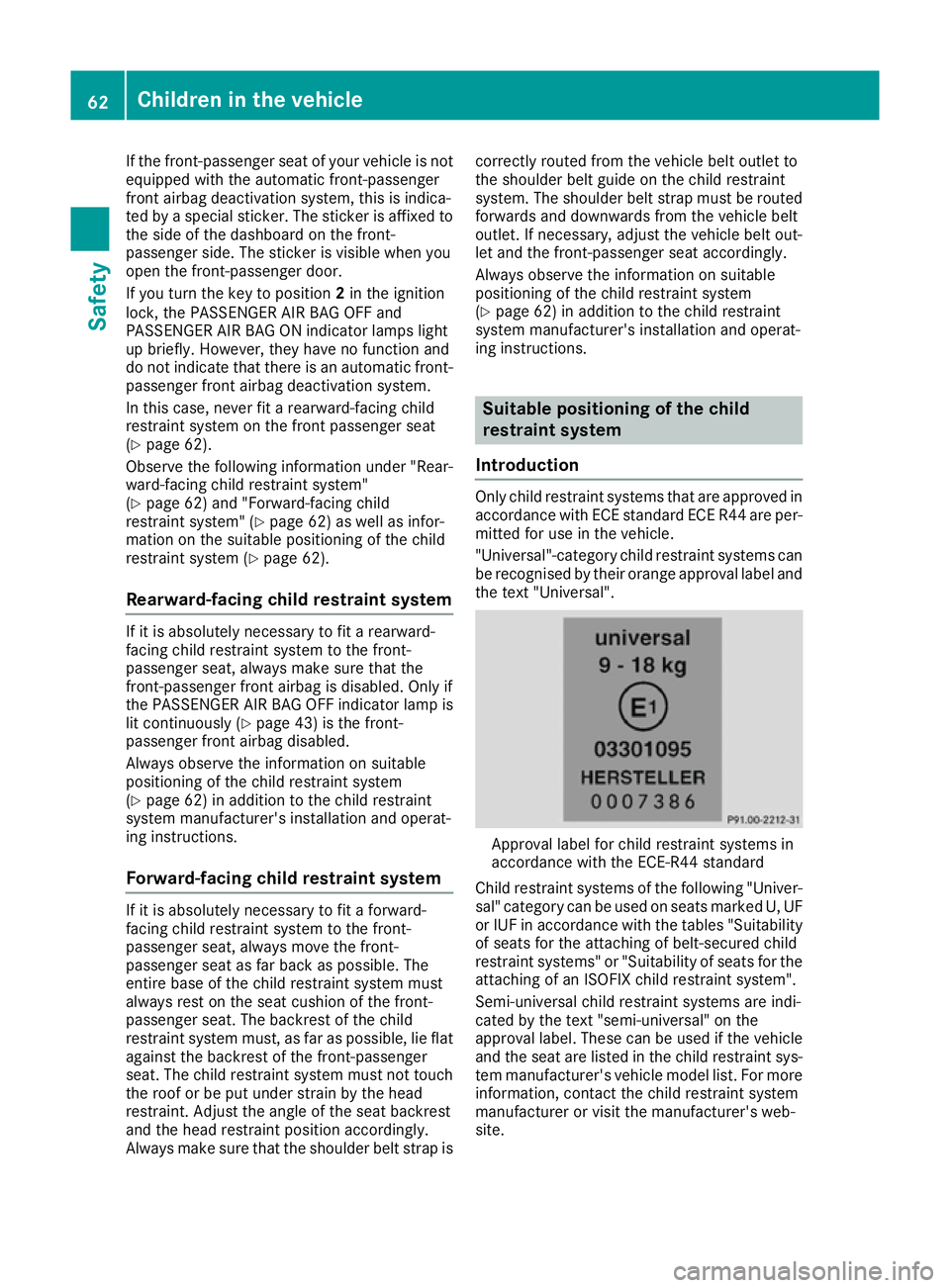
If the front-passenger seat of your vehicle is not
equipped with the automatic front-passenger
front airbag deactivation system, this is indica-
ted by a special sticker. The sticker is affixed to
the side of the dashboard on the front-
passenger side. The sticker is visible when you
open the front-passenger door.
If you turn the key to position 2in the ignition
lock, the PASSENGER AIR BAG OFF and
PASSENGER AIR BAG ON indicator lamps light
up briefly. However, they have no function and
do not indicate that there is an automatic front- passenger front airbag deactivation system.
In this case, never fit a rearward-facing child
restraint system on the front passenger seat
(Y page 62).
Observe the following information under "Rear-
ward-facing child restraint system"
(Y page 62) and "Forward-facing child
restraint system" (Y page 62) as well as infor-
mation on the suitable positioning of the child
restraint system (Y page 62).
Rearward-facing child restraint system If it is absolutely necessary to fit a rearward-
facing child restraint system to the front-
passenger seat, always make sure that the
front-passenger front airbag is disabled. Only if
the PASSENGER AIR BAG OFF indicator lamp is lit continuously (Y page 43) is the front-
passenger front airbag disabled.
Always observe the information on suitable
positioning of the child restraint system
(Y page 62) in addition to the child restraint
system manufacturer's installation and operat-
ing instructions.
Forward-facing child restraint system If it is absolutely necessary to fit a forward-
facing child restraint system to the front-
passenger seat, always move the front-
passenger seat as far back as possible. The
entire base of the child restraint system must
always rest on the seat cushion of the front-
passenger seat. The backrest of the child
restraint system must, as far as possible, lie flat against the backrest of the front-passenger
seat. The child restraint system must not touch the roof or be put under strain by the head
restraint. Adjust the angle of the seat backrest
and the head restraint position accordingly.
Always make sure that the shoulder belt strap is correctly routed from the vehicle belt outlet to
the shoulder belt guide on the child restraint
system. The shoulder belt strap must be routed
forwards and downwards from the vehicle belt
outlet. If necessary, adjust the vehicle belt out-
let and the front-passenger seat accordingly.
Always observe the information on suitable
positioning of the child restraint system
(Y page 62) in addition to the child restraint
system manufacturer's installation and operat-
ing instructions. Suitable positioning of the child
restraint system
Introduction Only child restraint systems that are approved in
accordance with ECE standard ECE R44 are per-
mitted for use in the vehicle.
"Universal"-category child restraint systems can
be recognised by their orange approval label and the text "Universal". Approval label for child restraint systems in
accordance with the ECE-R44 standard
Child restraint systems of the following "Univer-
sal" category can be used on seats marked U, UF or IUF in accordance with the tables "Suitabilityof seats for the attaching of belt-secured child
restraint systems" or "Suitability of seats for the
attaching of an ISOFIX child restraint system".
Semi-universal child restraint systems are indi-
cated by the text "semi-universal" on the
approval label. These can be used if the vehicle
and the seat are listed in the child restraint sys-
tem manufacturer's vehicle model list. For more information, contact the child restraint system
manufacturer or visit the manufacturer's web-
site. 62
Children in the vehicleSafety
Page 66 of 397
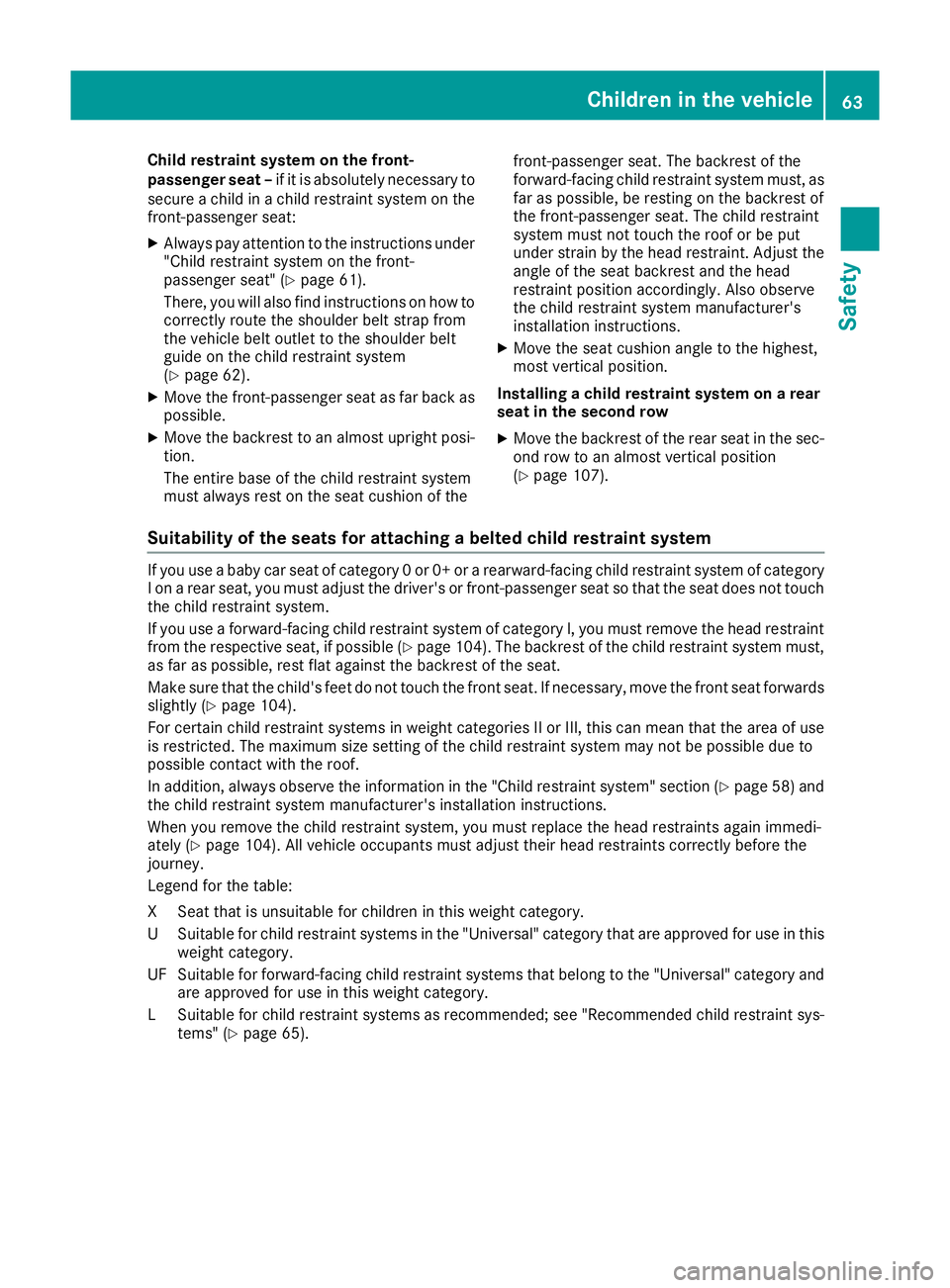
Child restraint system on the front-
passenger seat –
if it is absolutely necessary to
secure a child in a child restraint system on the front-passenger seat:
X Always pay attention to the instructions under
"Child restraint system on the front-
passenger seat" (Y page 61).
There, you will also find instructions on how to
correctly route the shoulder belt strap from
the vehicle belt outlet to the shoulder belt
guide on the child restraint system
(Y page 62).
X Move the front-passenger seat as far back as
possible.
X Move the backrest to an almost upright posi-
tion.
The entire base of the child restraint system
must always rest on the seat cushion of the front-passenger seat. The backrest of the
forward-facing child restraint system must, as far as possible, be resting on the backrest of
the front-passenger seat. The child restraint
system must not touch the roof or be put
under strain by the head restraint. Adjust the
angle of the seat backrest and the head
restraint position accordingly. Also observe
the child restraint system manufacturer's
installation instructions.
X Move the seat cushion angle to the highest,
most vertical position.
Installing a child restraint system on a rear
seat in the second row
X Move the backrest of the rear seat in the sec-
ond row to an almost vertical position
(Y page 107).
Suitability of the seats for attaching a belted child restraint system If you use a baby car seat of category 0 or 0+ or a rearward-facing child restraint system of category
I on a rear seat, you must adjust the driver's or front-passenger seat so that the seat does not touch the child restraint system.
If you use a forward-facing child restraint system of category I, you must remove the head restraint
from the respective seat, if possible (Y page 104). The backrest of the child restraint system must,
as far as possible, rest flat against the backrest of the seat.
Make sure that the child's feet do not touch the front seat. If necessary, move the front seat forwards
slightly (Y page 104).
For certain child restraint systems in weight categories II or III, this can mean that the area of use
is restricted. The maximum size setting of the child restraint system may not be possible due to
possible contact with the roof.
In addition, always observe the information in the "Child restraint system" section (Y page 58) and
the child restraint system manufacturer's installation instructions.
When you remove the child restraint system, you must replace the head restraints again immedi-
ately (Y page 104). All vehicle occupants must adjust their head restraints correctly before the
journey.
Legend for the table:
XS eat that is unsuitable for children in this weight category.
US uitable for child restraint systems in the "Universal" category that are approved for use in this
weight category.
UF Suitable for forward-facing child restraint systems that belong to the "Universal" category and are approved for use in this weight category.
LS uitable for child restraint systems as recommended; see "Recommended child restraint sys-
tems" (Y page 65). Children in the vehicle
63Safety Z
Page 69 of 397
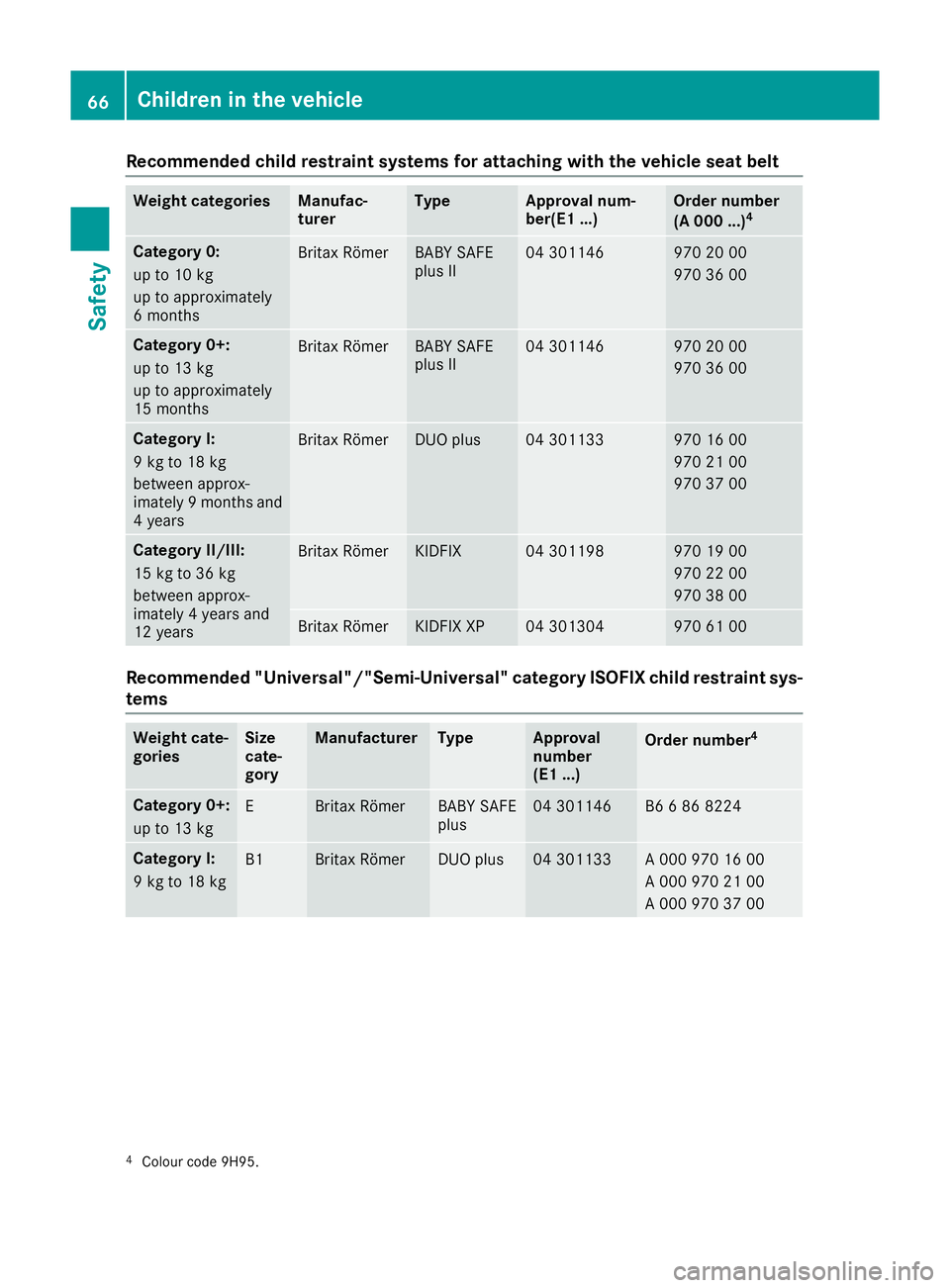
Recommended child restraint systems for attaching with the vehicle seat belt
Weight categories Manufac-
turer Type Approval num-
ber(E1 ...) Order number
(A 000 ...)
4 Category 0:
up to 10 kg
up to approximately
6 months
Britax Römer BABY SAFE
plus II 04 301146 970 20 00
970 36 00
Category 0+:
up to 13 kg
up to approximately
15 months
Britax Römer BABY SAFE
plus II 04 301146 970 20 00
970 36 00
Category I:
9 kg to 18 kg
between approx-
imately 9 months and
4 years Britax Römer DUO plus 04 301133 970 16 00
970 21 00
970 37 00
Category II/III:
15 kg to 36 kg
between approx-
imately 4 years and
12 years
Britax Römer KIDFIX 04 301198 970 19 00
970 22 00
970 38 00
Britax Römer KIDFIX XP 04 301304 970 61 00
Recommended "Universal"/"Semi-Universal" category ISOFIX child restraint sys-
tems Weight cate-
gories Size
cate-
gory Manufacturer Type Approval
number
(E1 ...)
Order number
4 Category 0+:
up to 13 kg
E Britax Römer BABY SAFE
plus 04 301146 B6 6 86 8224
Category I:
9 kg to 18 kg
B1 Britax Römer DUO plus 04 301133 A 000 970 16 00
A 000 970 21 00
A 000 970 37 00
4
Colour code 9H95. 66
Children in the vehicleSafety
Page 80 of 397

radar sensors checked at a qualified specialist
workshop. This also applies to collisions at low
speeds where no damage to the front of the
vehicle is visible.
Following damage to the windscreen, have the
configuration and operation of the camera sys-
tem checked at a qualified specialist workshop.
Function X
To activate or deactivate: activate or deac-
tivate Active Brake Assist with cross-traffic
function using the on-board computer
(Y page 250).
If the Active Brake Assist with cross-traffic
function is deactivated, the æsymbol
appears in the multifunction display.
If you have activated DSR (Y page 227), the
Active Brake Assist with cross-traffic function is
deactivated.
This function issues a warning:
R at a speed of approximately 30 km/h or
higher, the distance maintained to the vehicle
travelling in front is insufficient for several
seconds.
The · distance warning lamp then lights
up in the instrument cluster.
R at a speed of approximately 7 km/h or more,
you rapidly approach a vehicle in front or a
pedestrian
An intermittent warning tone will then sound
and the ·distance warning lamp will light
up on the instrument cluster.
X Brake immediately to defuse the situation.
or
X Take evasive action provided it is safe to do
so.
Active Brake Assist with cross-traffic function
can also brake the vehicle automatically under
the following conditions:
R the driver and front passenger have their seat
belts fastened
and
R the vehicle speed is between approximately
7 km/h and 200 km/h Up to a speed of approximately 70 km/h, Active
Brake Assist with cross-traffic function may
react to:
R stationary objects in the path of your vehicle,
such as stopped or parked vehicles
R pedestrians in the path of your vehicle
i If an increased danger of collision exists,
preventative passenger protection measures
(PRE-SAFE ®
) are triggered (Y page 56).
If the risk of collision remains and you do not
brake, take evasive action or accelerate quickly,
the vehicle may perform automatic braking up to
the point of a full brake application. An auto-
matic full brake application is not performed
until immediately prior to an imminent accident.
If you apply the brake yourself in a critical sit-
uation or during autonomous braking, braking
assistance is provided according to the situa-
tion. If necessary, this increases the brake pres-
sure up to full brake application.
To avoid a collision, Active Brake Assist with
cross-traffic function calculates the brake force
necessary if:
R you approach an obstacle and
R Active Brake Assist with cross-traffic function
has detected a risk of a collision
When driving at a speed under30 km/h: if
you depress the brake pedal, Active Brake
Assist with cross-traffic function is activated.
Braking assistance from Active Brake Assist
with cross-traffic function is carried out at the
last possible moment.
When driving at a speed above30 km/h: if
you depress the brake pedal sharply, Active
Brake Assist with cross-traffic function auto-
matically increases the brake pressure to a
degree suited to the traffic situation.
Active Brake Assist with cross-traffic function
provides braking assistance in hazardous situa-
tions with vehicles in front within a speed range
between 7 km/h and 250 km/h. Driving safety systems
77Safety Z
Page 105 of 397
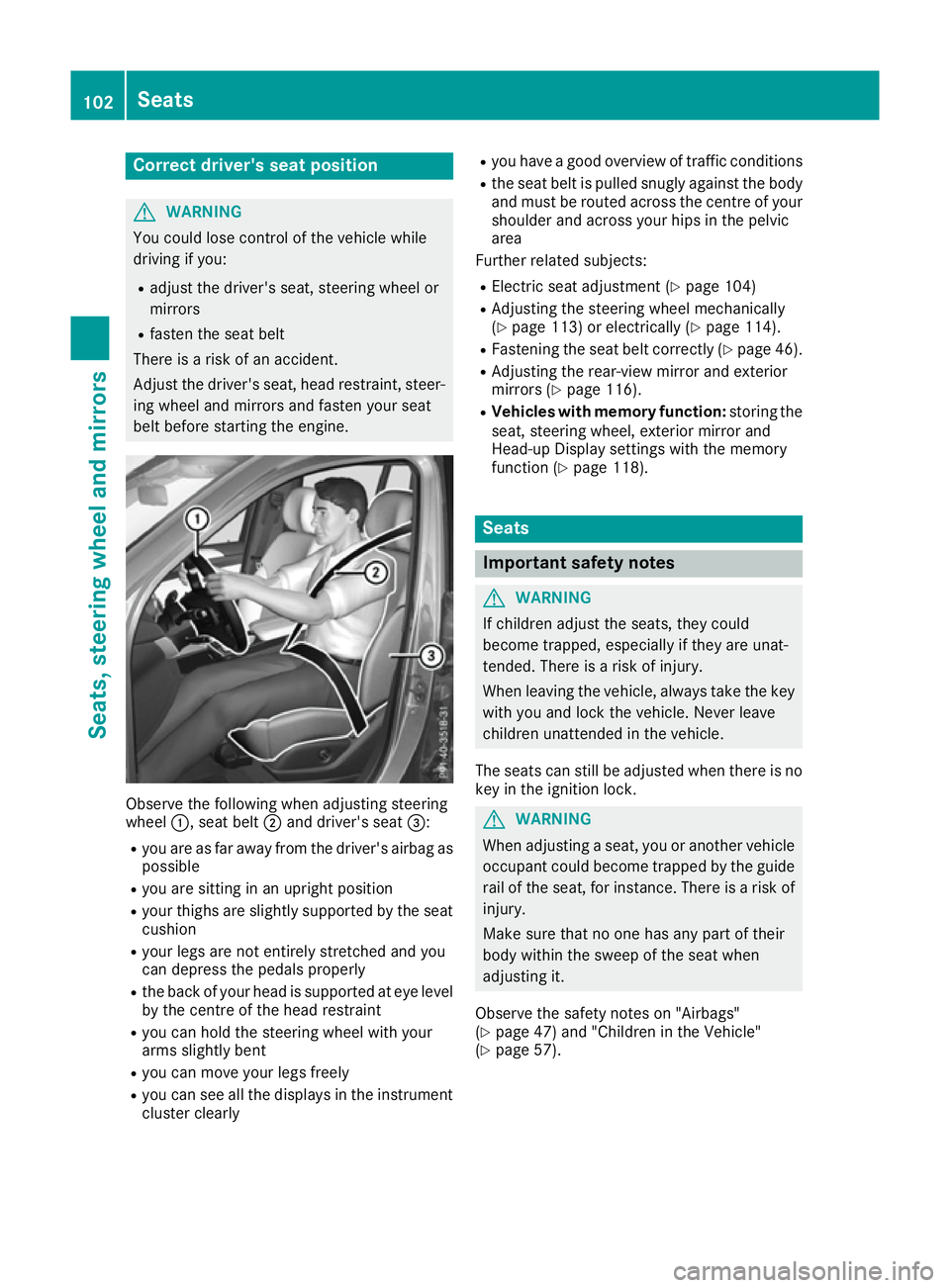
Correct driver's seat position
G
WARNING
You could lose control of the vehicle while
driving if you:
R adjust the driver's seat, steering wheel or
mirrors
R fasten the seat belt
There is a risk of an accident.
Adjust the driver's seat, head restraint, steer-
ing wheel and mirrors and fasten your seat
belt before starting the engine. Observe the following when adjusting steering
wheel
:, seat belt ;and driver's seat =:
R you are as far away from the driver's airbag as
possible
R you are sitting in an upright position
R your thighs are slightly supported by the seat
cushion
R your legs are not entirely stretched and you
can depress the pedals properly
R the back of your head is supported at eye level
by the centre of the head restraint
R you can hold the steering wheel with your
arms slightly bent
R you can move your legs freely
R you can see all the displays in the instrument
cluster clearly R
you have a good overview of traffic conditions
R the seat belt is pulled snugly against the body
and must be routed across the centre of your
shoulder and across your hips in the pelvic
area
Further related subjects:
R Electric seat adjustment (Y page 104)
R Adjusting the steering wheel mechanically
(Y page 113) or electrically (Y page 114).
R Fastening the seat belt correctly (Y page 46).
R Adjusting the rear-view mirror and exterior
mirrors (Y page 116).
R Vehicles with memory function: storing the
seat, steering wheel, exterior mirror and
Head-up Display settings with the memory
function (Y page 118). Seats
Important safety notes
G
WARNING
If children adjust the seats, they could
become trapped, especially if they are unat-
tended. There is a risk of injury.
When leaving the vehicle, always take the key with you and lock the vehicle. Never leave
children unattended in the vehicle.
The seats can still be adjusted when there is no
key in the ignition lock. G
WARNING
When adjusting a seat, you or another vehicle occupant could become trapped by the guiderail of the seat, for instance. There is a risk of
injury.
Make sure that no one has any part of their
body within the sweep of the seat when
adjusting it.
Observe the safety notes on "Airbags"
(Y page 47) and "Children in the Vehicle"
(Y page 57). 102
SeatsSeats, steering wheel and
mirrors